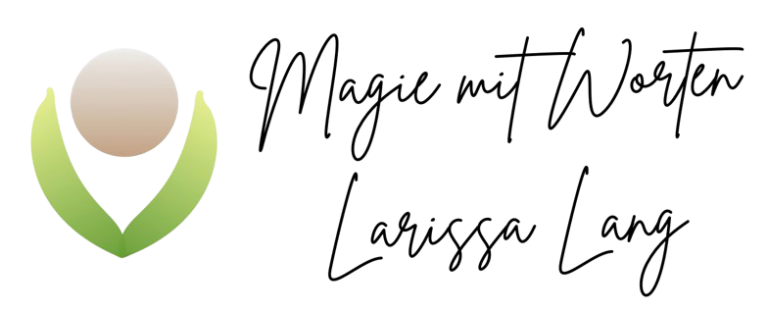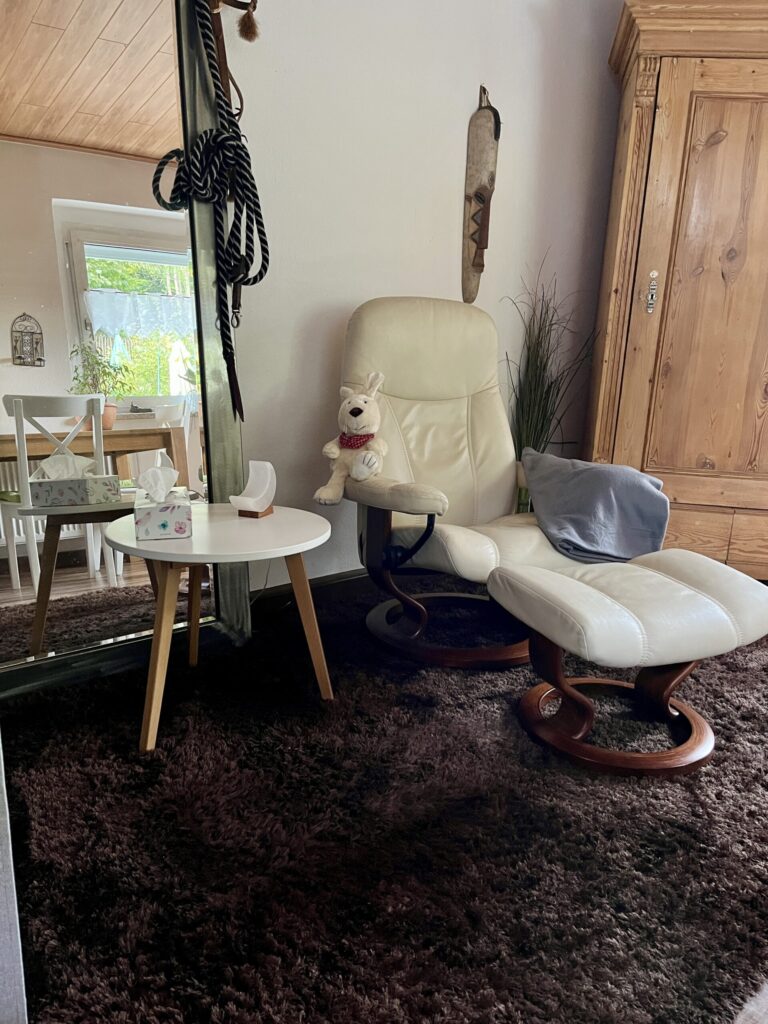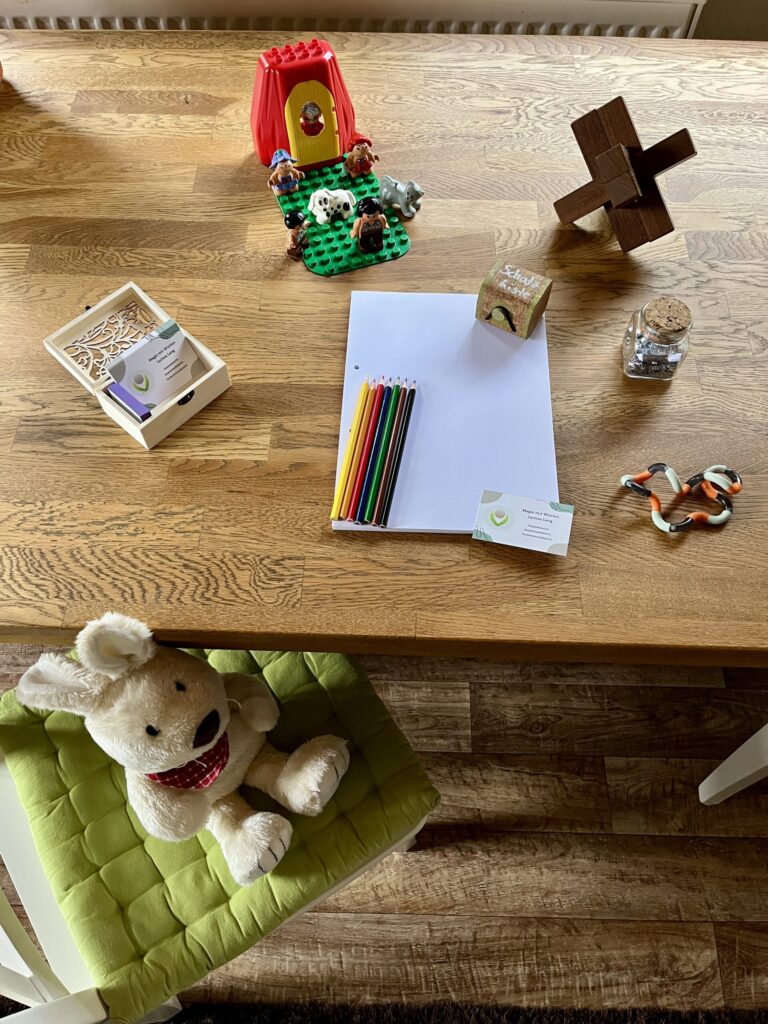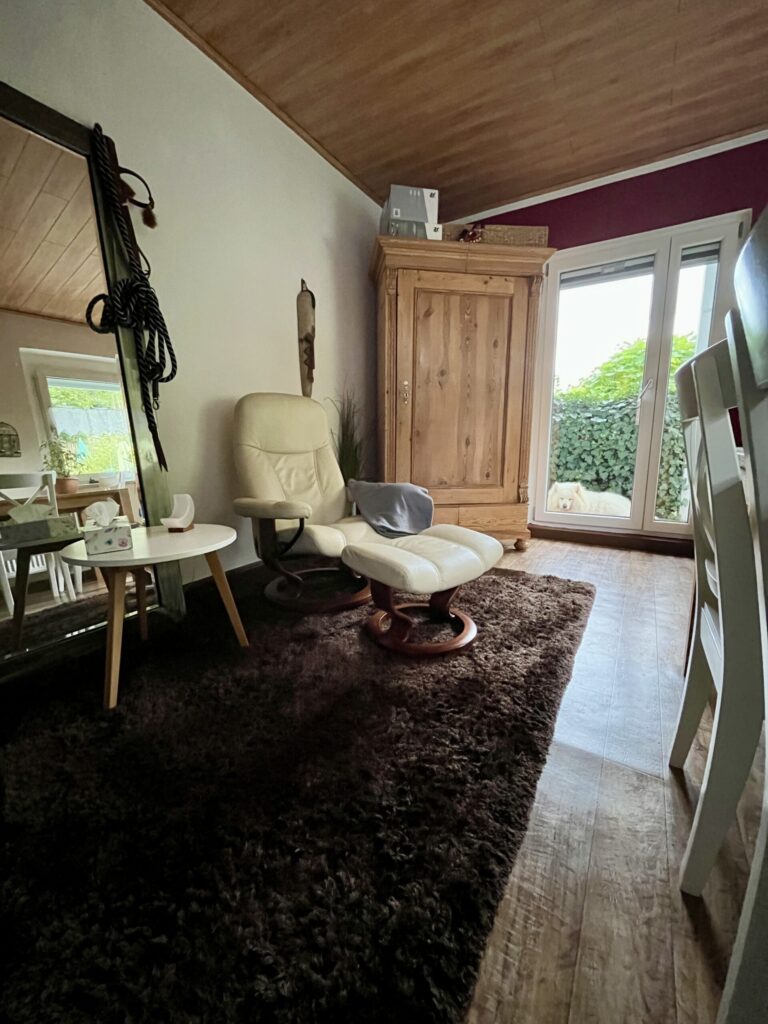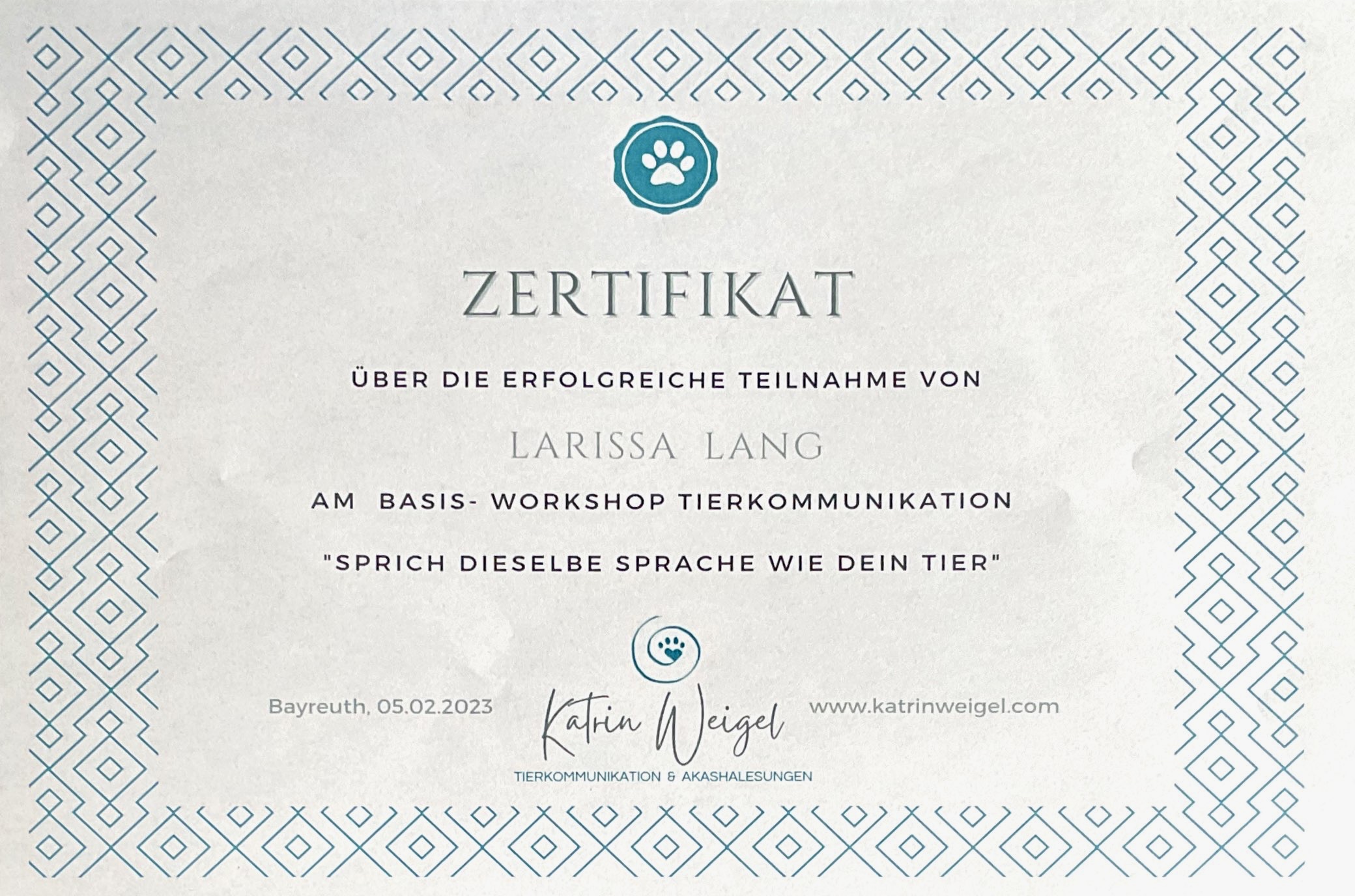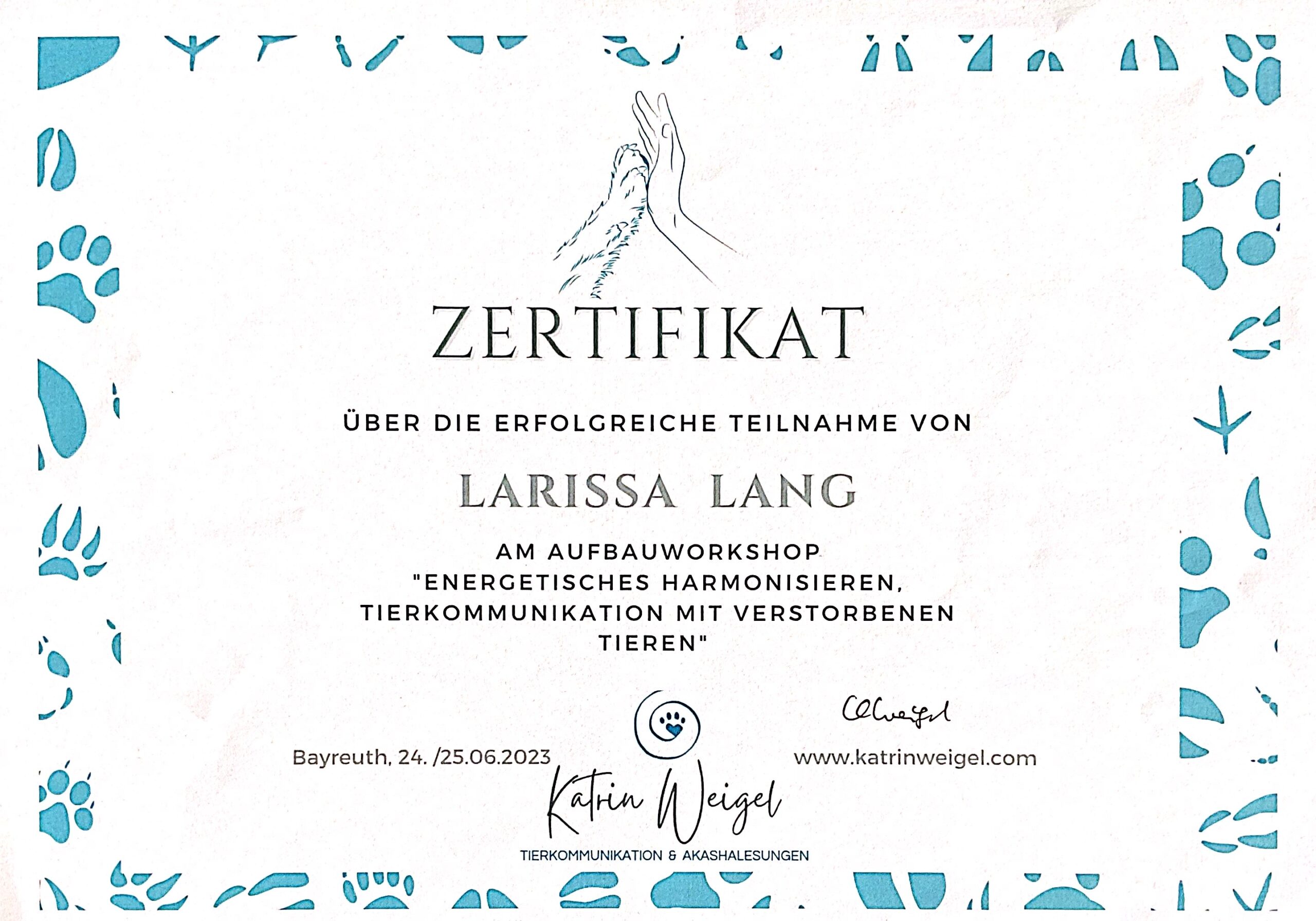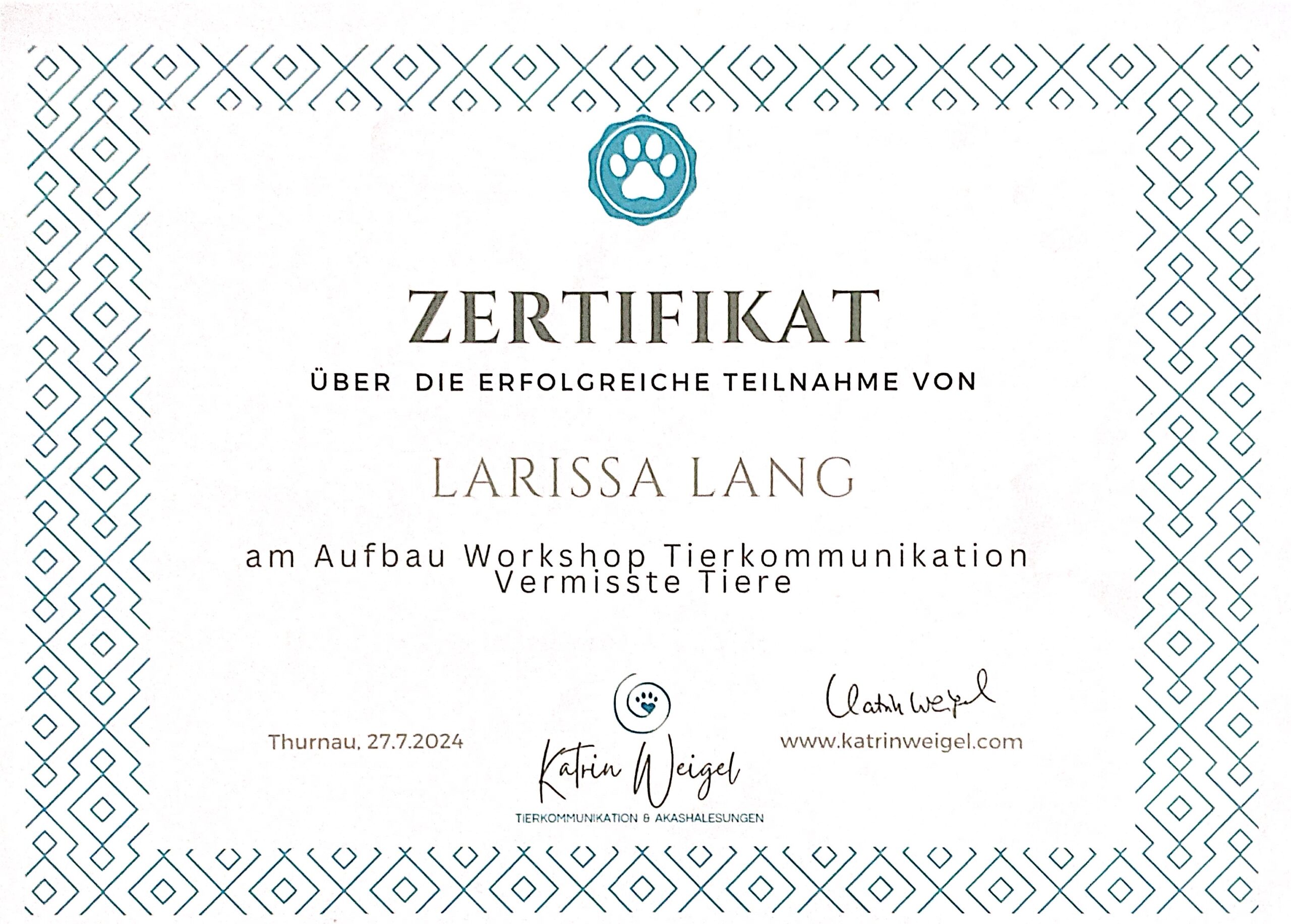Animal consultation hour
Everything that happens happens for a good reason, even if you don’t always know or notice it right away. People always worry and think too much, even though it doesn’t help them to do so. Life must be lived forward, but can only be understood backward. … – Cat Bounty
This is an original statement (slightly adapted) by Cat Bounty, who chose very wise words in animal communication and thus moved her owner to tears.
From 232€
Beate Herrmann
Larissa helped me a lot with animal communication. It’s absolutely amazing what she found out and how accurate her statements are.
Thank you very much, I highly recommend her!

Living animal - Answers for many questions

Animal communication with living animals: Your connection to your sweetheart
Have you ever wondered what your pet is thinking about you right now? For example, when you’re jumping around again out of sheer exuberance or have just turned the music up really loud… Also questions like: Is my ball of fur happy? Does it its like food or is it missing something? Perhaps you have already asked yourself these or similar questions… How does your fur baby perceive your relationship? As an animal communicator, I can help you to finally answer these and many other questions in order to establish and strengthen an even deeper connection with your pet.
Finally understand your pet’s thoughts and feelings
Animals have an incredible ability to express their love and loyalty in a silent but powerful way. Sometimes, however, their inner world remains hidden from us. Through animal communication, we can cross this invisible bridge and dive directly into your pet’s mind.
What is my animal thinking about me right now?
Perhaps it has often looked at you curiously and you have wondered what is going on in your darlings head right now. Animals are full of emotions and thoughts, but unfortunately they are often unable to communicate them to us directly. They try in their own special way, but if you and I are honest with each other, we unfortunately don’t understand. No matter how hard we try… Kazian, Hundisch or Hasisch are not so easy to learn… Through animal communication, I can find out how your animal sees you and what it particularly appreciates about you.
Is your pet happy?
The well-being of your pet is important to both you and me. Pet owners often ask themselves: Is my pet happy, is it comfortable in its home, is there anything I can do for it? By talking to your furry friend, I can find out whether it feels happy or whether there is something that is bothering it. Maybe your furball wants more playtime or more treats? 😉 Every little insight can help you to make your pet’s life a lot better.
Find out what your pet is missing
It’s heartbreaking when you realise something is wrong but you don’t know what it is. You visit a vet, but they can only tell you that everything is fine from a medical point of view. Animal communication can help to uncover the problems and find solutions.
Strengthen the bond between you and your pet
Your relationship with your pet is unique and precious. No one has ever had and will ever have the same special connection as you. You are very special to your furry friend. It’s amazing how deeply animals feel and how much they value their bond with us. Through animal communication, I can help you understand your pet’s perspectives. Sometimes they even have suggestions on how you can make your relationship even closer and more harmonious.
Your animal as a partner and friend
Animals are not just loyal companions; they are friends, confidants and family members. They feel our joy, comfort us in difficult times and give us unconditional love. You will be amazed at how much your pet knows about you and what it wants to tell you. How much it is looking forward to finally being understood by you.
Your next step
Would you like to better understand your pet’s thoughts and feelings? Then now is the perfect time to book an animal communication session. Let’s open the door to a new level of understanding and love together.
I look forward to transmitting your animal’s messages to you.
Review from a satisfied client (on Proven Expert)
Larissa helped me a lot with an animal communication. It was absolutely amazing what she found out and how accurate her statements are.
Thank you very much for this, really highly recommended!
Beate Herrmann
Satisfied cat owner

Appointment booking
- Click on “Done” after booking.
Book your next animal communication session within approximately two weeks.
You get:
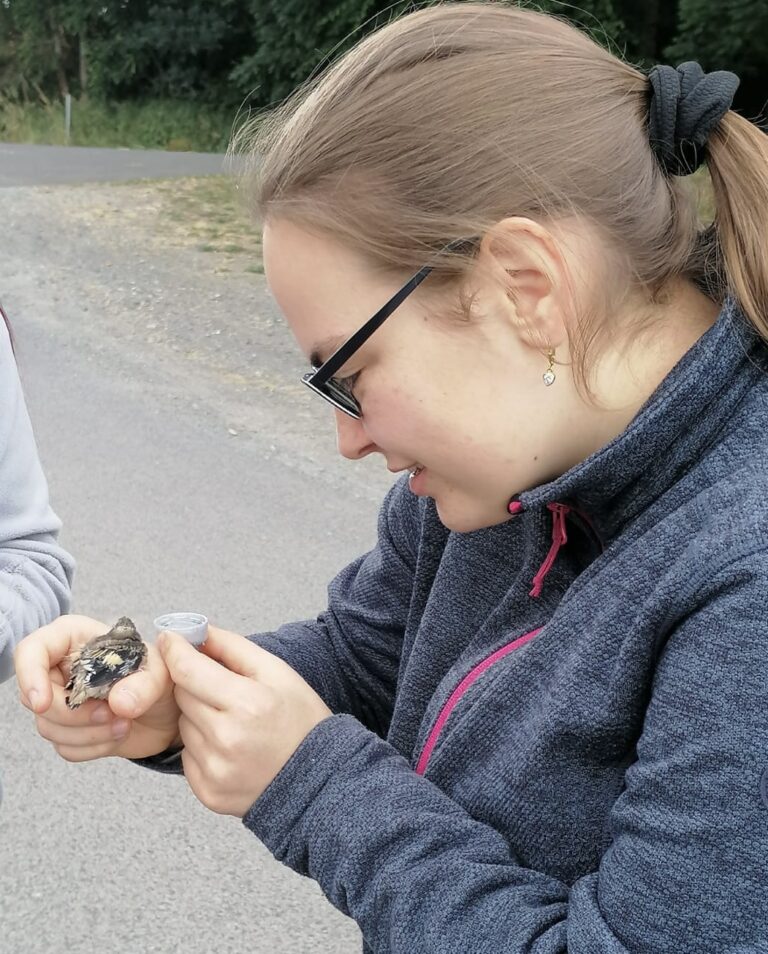
Am I the right one for you (or your furry friend)?
You are in the right place with me when:
- You are ready to change yourself and your life
- You *don't* want to carry on as before
- You finally want to lead a free, self-determined and carefree life
- You take the initiative for change
- You want support from me
- You see hypnosis as a tool to help you on your journey
- You are looking for support for your whole family (including animals)
You are in the wrong place with me when:
- You *don't* want to follow my suggestions for action
- You think that I will do the work for you
- You love to stay in your comfort zone
- You are looking for an excuse / proof that you are a hopeless case or want to prove to me that hypnosis doesn't work
- You have no trust in hypnosis and in me / to me
- You expect a result within a few seconds
- You want to stop smoking and / or lose weight
Hey, I am Larissa
Coach for humans and animals
Hypnotist, quantum worker, animal communicator and coach for humans and animals.
I love non-fiction and specialist books, as well as psychology and spirituality.
I think that every child should have a carefree childhood. I want to support families (especially children and animals) to rediscover their own resources (which are in each of us) and thus enable a free and carefree life. It’s not that difficult.
I have been interested in hypnosis etc. since the age of 12 and have therefore read a lot about it in books, listened to podcasts and watched videos. Even in languages that I don’t even come close to understanding. So I decided back in 2015 that I wanted to help (especially families and animals).

What makes me unique
Continuous further training in various areas
Both subject-specific and non-subject-specific
Individual, goal-oriented work and no schema F or simply reading off scripts
In terms of age, I can understand children even better than someone who has been out of school for over 40 years
I work across disciplines and combine different approaches for maximum results
(hypnosis and animal communication, hypnosis and quantum work, quantum work and animal communication etc.)
I have enjoyed many comprehensive and high-quality training courses
I always want to find the best solution for you individually
I have specialized in families (with fur noses), surrogate work for animals and spiritual hypnosis and therefore don’t do everything.
For example, I don’t do quit smoking and / or weight loss…!
I have experienced hypnosis and quantum work for myself and am in a constant process of development and am continuously working on myself (also with the help of hypnosis, quantum work etc.) in order to be able to support you in the best possible way
Review from a satisfied client (on Proven Expert)
I booked Ms. Lang for an animal communication session.
The client receives the result in writing, preliminary talks were very informative. The assignment (questions for the animal) is determined in advance, so that I as the client also have the opportunity to address specific issues. I find that very good.
At the results meeting, Ms. Lang explains the protocol and it is very informative. Any queries are explained very well and clearly.
I hope to be able to help my cat better with the information and will let the animal communication work on us.
Thank you for your work and the trust you have placed in us.
Andrea Kurth
Satisfied dog owner

Brief overview of animal communication
What is animal communication?
- Short AC
- Telepathic communication with animals
- Through thoughts / feelings / emotions / images
- Tele = distance (Greek)
- Pathos = feeling, experience, initiation (Greek)
Requirements animal communication
- Consent of the owner
- Name of the animal (no nickname)
- Current picture of the animal (where it looks best into the camera and is fully visible => You can find an example image below)
- Ideally also a photo of you as the owner (preferably current and where you are looking into the camera)
- Specific and concise questions (no question in the question)
How does animal communication work?
Very good! 😉
Just kidding!
Telepathically through:
- Images
- Thought
- Spoken words
- Information
- Etc.
- Not by making animal sounds at each other…
Animal communication process
- Contact / Appointment booking
- (Initial consultation) Intake form
- Preliminary discussion (if you would like to describe your situation in more detail)
- Contact with your animal
- Follow-up discussion + you receive the consultation transcript
- Follow-up contacts
Possibilities and limitations of animal communication
Possibilities:
- Farewell, Clarity & Consolation
- Conveying messages
- Insights into the emotional life of the animal and its wishes / needs
- Promoting mutual trust
- Help with blockages
- Clarifying and harmonizing conflicts
- Finding solutions
Recognizing mirror issues - Strengthening the human-animal relationship
- Detecting and understanding the causes of behavioral problems / changes
- Preparation for upcoming changes
Important: Everything in addition to veterinary treatment!
Limitations:
- Replace veterinary or medical diagnostics and treatment
- Be purely an “educational measure”
- Restrict an animal’s free will
- Make promises of healing
- Making contact with other animals without the animal owner’s permission (except for wild animals)
- Ignore the animal’s refusal to make contact (or other interventions such as energetic harmonisation)
Worth knowing animal communication
Animals can also lie (for their own protection):
- E.g. animal hurts paw
- Nothing visible on the outside
- Animal is afraid of the vet
- Therefore conceals pain
- When asked if it is in pain, it lies to avoid the vet
Mirror themes:
- The animal mirrors the owner’s behaviour (but the owner is not always aware of this)
- Animal keeps repeating a behaviour that was not there before
- Animal shows behavioural abnormalities
Q&A
Here you will find the most frequently asked questions and answers.
If your question is not listed here, you may find the answer on the Q&A page.
If you still cannot find the answer there, you are welcome to book an prelininary talk at any time. During this meeting, you can ask me any questions you may have. For those who are more introverted, there is of course also the option of sending me an email.
Does animal communication also work with... ?
Yes, animal communication will most likely also work with your animal.
As long as the animal has a name and an owner or keeper and the owner or keeper agrees to me talking to the animal (and the animal is also willing to talk to me), animal communication is possible.
Animal communication with … possible: hamster, rabbit, guinea pig, bird? -> Yes!
Of course, it is also possible with “classic animals” such as dogs, cats, horses, but also with unusual animals such as tortoises, bees, raccoons and so on.
Animal communication can also take place with animals that can already speak (e.g. parrots).
If you have an animal rescue center or something similar (also animal shelter, foster home etc.), and the animals do not belong to you, please contact me anyway ( LarissaLang@magiemitworten.com ). This is the only way I can work with you to see whether and if so, how animal communication can also be achieved for this animal 😉
Here you can find some animals:
If your animal is not included in this list or if it is a wild animal (an animal without an owner), please feel free to contact me. I will then check individually whether animal communication with the animal is possible.
PS: Even “special” animals, such as assistance animals, rescue animals, or competition animals, can benefit greatly from animal communication.
Can you ask my (also already deceased) animal xyz?
Yes, I probably can. You simply write me all your questions (max. 5 per animal communication, otherwise it gets too much) and I ask them to your animal. I will then send you the answers (in written form and we will discuss everything again in a Zoom).
By the way, if you want to ask a question that I don’t want to or can’t ask (ethically, morally etc.) I will tell you and you can then formulate another question 😉
Can you find my missing animal?
Unfortunately, I can’t give a general answer / promise. However, the chances are usually very good that I can find out whether your pet is well and possibly also where he/she is at the moment. However, there is much more to animal communication with missing animals than just answering these questions…
Can I look over your shoulder to see how you do animal communication?
No. Every animal communication (just like hypnosis or quantum work, for example) is very individual. Apart from that, you would only see me sitting there writing with the photo of the animal, the questions and a writing utensil.
No, I’m not sitting in a room covered in incense smoke and I’m not wearing a white robe. Nor am I performing a dance or making any mystical sounds.
I also don’t sit opposite the animal and bark at it and it barks back (if it’s a dog, for example).
Do your sit opposite the animal and bark at it, for example? (In the case of a dog)
No, I don’t sit opposite the animal and bark at it and it barks back (if it’s a dog, for example).
Apart from that, I imagine it is somehow very complicated to communicate with a giraffe or an earthworm, for example, in this way. Firstly, because I’m not as tall as a giraffe (and I don’t think climbing a ladder is such a good idea either) and secondly, I don’t even know what sounds / noises an earthworm makes, for example.
